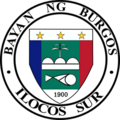Burgos | |
|---|---|
| Municipality of Burgos | |
| Motto: Ayos Burgos! | |
 Map of Ilocos Sur with Burgos highlighted | |
 Interactive map of Burgos | |
Location within the Philippines | |
| Coordinates: 17°19′59″N120°29′40″E / 17.3331°N 120.4944°E | |
| Country | Philippines |
| Region | Ilocos Region |
| Province | Ilocos Sur |
| District | 2nd district |
| Named after | José Burgos |
| Barangays | 26 (see Barangays) |
| Government | |
| • Type | Sangguniang Bayan |
| • Mayor | Nathaniel D. Escobar |
| • Vice Mayor | Riolita R. Balbalan |
| • Representative | Kristine Singson-Meehan |
| • Municipal Council | Members |
| • Electorate | 9,023 voters (2025) |
| Area | |
• Total | 44.38 km2 (17.14 sq mi) |
| Elevation | 71 m (233 ft) |
| Highest elevation | 439 m (1,440 ft) |
| Lowest elevation | 0 m (0 ft) |
| Population (2024 census) [3] | |
• Total | 13,026 |
| • Density | 293.5/km2 (760.2/sq mi) |
| • Households | 3,135 |
| Economy | |
| • Income class | 4th municipal income class |
| • Poverty incidence | 18.59 |
| • Revenue | ₱ 631.3 million (2022) |
| • Assets | ₱ 1,972 million (2022) |
| • Expenditure | ₱ 327 million (2022) |
| • Liabilities | ₱ 49.91 million (2022) |
| Service provider | |
| • Electricity | Ilocos Sur Electric Cooperative (ISECO) |
| Time zone | UTC+8 (PST) |
| ZIP code | 2724 |
| PSGC | |
| IDD : area code | +63 (0)77 |
| Native languages | Ilocano Tagalog |
Burgos, officially the Municipality of Burgos (Ilocano : Ili ti Burgos; Filipino : Bayan ng Burgos) is a municipality in the province of Ilocos Sur, Philippines. According to the 2024 census, it has a population of 13,026 people. [5]


